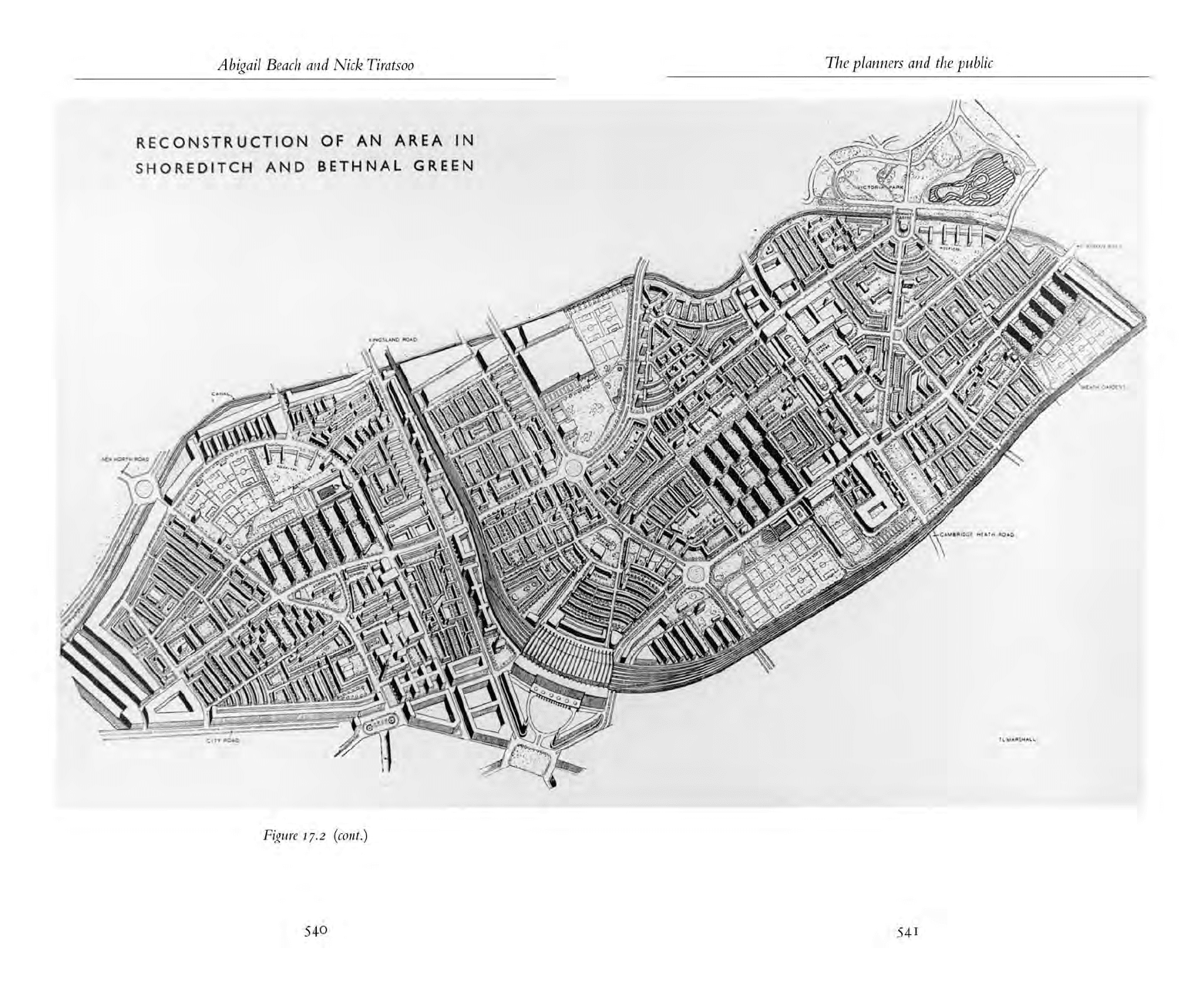Daunton M. The Cambridge Urban History of Britain, Volume 3: 1840-1950
Подождите немного. Документ загружается.


to promote democratic participation across class lines’ and ‘the constantly intru-
sive presence of the Company in the affairs and decision-making of the com-
munity cast a paternalistic pall over the enterprise’.
32
A comparable tension also emerged at Hampstead Garden Suburb and in
other communities built on the co-partnership model during this period.
33
The
planners’ rhetoric stressed the social value of mixed neighbourhoods, but a con-
ception of ‘equality’ was noticeably absent. Instead, the dominant sentiments
were ‘fraternity’, ‘community’ and ‘fellowship’.
34
The actual involvement of
tenants in the running of the estates varied widely and, in the cases of the flagship
Ealing and Hampstead Tenants’ Societies, was very quickly diminished. The
Ealing society, whose initial management committee consisted of eleven
members, seven of whom were tenants, ‘had inherited the Tenant Co-partners’
rule of one person one vote’. However, this policy was changed between
and : the new constitution allowed voting by proxy and, crucially, awarded
‘an additional vote for every set of ten shares held’.
35
Interestingly, both at Ealing
and at Hampstead Garden Suburb, associations of tenants were formed in the
aftermath of this change ‘to advocate the return to those principles of true co-
partnership in housing, the wilful or careless neglect of which has been the fruit-
ful cause of much discontent among the Hampstead Tenant Shareholders, and
others’.
36
Other societies maintained a degree of tenant involvement at the level
of the management committee beyond the First World War, but it is clear that
pressure from commercial interests strained the relationship between non-tenant
members and tenants at various points during their history.
37
At a time when the questions of landownership and taxation had become
highly politicised, co-partnership housing and site planning tended to be seen as
a less controversial substitute for more elemental reform. In a similar way, the
Housing and Town Planning Act, while it reflected the contemporary res-
onance of the garden city idea, clearly stopped short of the movement’s ideals.
Under its provisions, local authorities were permitted to prepare town planning
schemes for land which was about to be developed or which ‘appeared likely
to be used for building purposes’, giving them power to control standards of
layout and impose conditions of development.
38
Existing built-up areas were
unaffected. Moreover, the municipalities were not given powers to acquire land
compulsorily for future town extension as many reformers, such as J. S.
Abigail Beach and Nick Tiratsoo
32
Meacham, ‘Raymond Unwin’, p. .
33
J. Birchall, ‘Co-partnership housing and the garden city movement’, Planning Perspectives,
(), –; K. J. Skilleter, ‘The role of public utility societies in early British town planning
and housing reform, –’, Planning Perspectives, (), –; M. Miller and A. Gray,
Hampstead Garden Suburb (Chichester, ).
34
Birchall, ‘Co-partnership housing’, .
35
Ibid., .
36
Quoted in Skilleter, ‘The role of public utility societies’, .
37
Birchall, ‘Co-partnership housing’, –.
38
S. M. Gaskell, ‘“The suburb salubrious”: town planning in practice’, in Sutcliffe, ed., British Town
Planning, pp. , .
Cambridge Histories Online © Cambridge University Press, 2008

Nettlefold and T. C. Horsfall, had urged.
39
As a result, planning was limited in
practice to suburban extension, and not the novel development envisaged by
Ebenezer Howard, and ‘as time passed, most observers came to agree that the
intricacies of the Act, which were designed mainly to protect private property,
were a serious obstacle’ to imaginative and community-orientated town
planning.
40
However, the dilution of the garden city model and the concurrent dwindling
of the co-partnership housing movement did not dissolve the town planning
movement’s exploration of the connection between tenure and citizen empow-
erment, for many planners and politicians now transferred their hopes to the
local authority, as the locus of community democracy. Labour and Fabian social-
ist reformers, whose numbers were beginning to swell the borough councils of
London and some other large urban centres, particularly supported the elected
local authority as the prime medium for a democratic housing and planning
policy. Raymond Unwin, himself a Fabian socialist, was in the forefront of this
shift, diverting his energies into the development of council housing during and
after the First World War. Yet, the interwar local government framework brought
its own constraints upon the development of a wide public involvement in the
planning process, not least of which was the failure to develop a comprehensive
framework for compensation and betterment.
Since the late Victorian and Edwardian periods, the problems of local govern-
ment finance, and the rating system in particular, had developed into an issue of
huge political importance.
41
From this was exacerbated by the rising social
demands placed upon local authorities and, as the post-war boom disintegrated
into slump and cutbacks, many found it increasingly difficult to meet the
demands made upon them. While social reconstruction, and particularly
housing and unemployment relief, remained at the forefront of political debate,
ratepayers’ associations and pressure from conservative municipal reform group-
ings seemingly put a ceiling on the raising of revenue from the traditional rates.
42
The local execution of town planning schemes was severely limited by this pres-
sure. While decentralisation of the working population into garden cities had
retained the imagination of the planners, and had gained the support of the
Labour party, both at national and local levels, the structure of local government
The planners and the public
39
G. E. Cherry, Cities and Plans (London, ), p. ; Nettlefold, Housing Policy; T. C. Horsfall,
The Improvement of the Dwellings and Surroundings of the People: The Example of Germany
(Manchester, ).
40
A. Sutcliffe, Towards the Planned City (Oxford, ), pp. , –; Gaskell, ‘“The suburb salu-
brious”’, .
41
J. Harris, ‘The transition to high politics in English social policy, –’, in M. Bentley and
J. Stevenson, eds., High and Low Politics in Modern Britain (Oxford, ), pp. –; Offer, Property
and Politics.
42
J. E. Cronin, The Politics of State Expansion:War, State and Society in Twentieth Century Britain (New
York, ), p. .
Cambridge Histories Online © Cambridge University Press, 2008

finance acted as a strong barrier to its practical implementation. Locating indus-
trial and retail activity within the city centre was a profitable strategy for local
authorities in terms of the collection of rates for its coffers. Suburban housing
development had brought similar benefits but with the greater restrictions of the
Ribbon Development Act this was an increasingly closed option. By way
of contrast, the building of out-county housing estates or satellite town devel-
opments would diminish the authorities’ rateable value. For many local author-
ities, therefore, the development of an innovative plan for decentralisation was,
virtually, financial folly. The issue was further compounded by the failure of
planning legislation to address successfully the problem of compensation and
betterment. The act had skirted around this issue, largely under pressure
from property interests, and while the Town Planning Act included provi-
sions for the recovery of betterment from owners whose property increased in
value as a result of a town planning scheme, it lacked strength to ensure imple-
mentation and was rarely effective. The result, Lewis Silkin, Labour’s town plan-
ning spokesman, argued in , was ‘the prevention of really bold and
imaginative schemes’with local authorities tending ‘to take the line of least resis-
tance and to prepare schemes which involve the minimum risk of compensa-
tion, generally based on the existing uses of land’.
43
Yet, while elements of the intellectual and political climate inhibited the artic-
ulation and development of a broadly participatory town planning process
during the interwar years, town planning thought undoubtedly retained an
interest in the potential social value of community-oriented planning. Much
town planning literature, for instance, continued to be informed by a rhetoric
of social integration and cooperation which stressed the importance of a vigor-
ous and participatory community life. This approach to town planning and
housing policy, indeed, seemed even more imperative in the light of the per-
ceived social and economic trends of the period, and in response to the specific
experiences of building during these years. The New Survey of London Life and
Labour, produced by Herbert Llewellyn Smith and his team of researchers from
, for example, assembled evidence of the continued segregation of the social
classes in London. While the middle classes were increasingly located in the bur-
geoning suburbs, the whole of London’s inner east was conversely characterised
by a high concentration of working-class families.
44
It was, moreover, a situation
which found echoes in other major urban locations, particularly in the Distressed
Areas, such as the north-east conurbation. Concern for the implications of this
unbalanced social structure was one of the ways in which the question of com-
munity continued to be examined in the interwar period. The development of
large, out-of-town housing estates, built primarily to resettle the slum-bound
Abigail Beach and Nick Tiratsoo
43
L. Silkin, The Nation’s Land (London, ), p. .
44
H. Llewellyn Smith, ed., New Survey of London Life and Labour (London, –); J. A. Yelling,
Slums and Redevelopment (London, ), p. .
Cambridge Histories Online © Cambridge University Press, 2008

working classes, occasioned widespread criticism. The huge Dagenham and
Becontree estate on the east London and Essex border, for example, became an
emblem among planners and sociologists, representing the problems that could
result from a social housing policy which, however well meaning, failed to con-
front the complexities of building for a new community.
45
Social integration, it
was quickly realised, required more than the building of new self-contained set-
tlements. Several points were highlighted.
One area of interwar town planning thought which addressed the question of
the relationship between the built environment and the developing community,
as noted above, focused on the social mix of the community. During this period,
indeed, a balanced mix between the social classes became, for many planners and
social commentators, the defining characteristic of good town planning. At the
centre of their criticism lay the policy of rehousing the working population in
out-county housing estates. Instead of building stable and integrated commu-
nities, local authorities had created new zones of exclusion. Looking back from
, L. E. White felt that the one-income estate had become ‘the true habitat
for a rootless generation’.
46
Yet, while this remained a popular view among plan-
ners and politicians, informing new towns and housing policy into the post-war
period, a number of commentators preferred to stress the advantages of social
homogeneity, often advocating the redevelopment of inner-city areas as an alter-
native policy.
47
This, they argued, was more in line with residents’ wishes. While
the physical infrastructure of many inner-city areas was admittedly deplorable, res-
idents found compensation in a positive social life and network. Mrs Bentwick’s
study of Bermondsey for the London County Council noted that although people
liked cottage homes in preference to flats, they nevertheless preferred flats in
Bermondsey to cottages elsewhere. ‘One reason for the happy atmosphere of the
Borough’, she argued, ‘is the fact that per cent of its population is working class.
It is the mixed boroughs like Kensington and Wandsworth which lack this extreme
civic pride and consciousness and sense of unity.’
48
At the heart of both view-
points lay a belief that good town planning required a positive interaction between
the planners and the public which they served. Yet, neither had developed a coher-
ent argument on how this might realistically be achieved.
A number of commentaries on town planning in the interwar years, however,
did stress the importance of understanding both the existing life and the future
hopes of incoming residents. For example, in their evaluation of the housing and
planning policy of the corporation of Bristol, Rosamund Jevons and John Madge
The planners and the public
45
For the development of Dagenham and Becontree, see A. Olechnowicz, Working-Class Housing
in England Between the Wars (Oxford, ).
46
L. E. White, Community or Chaos? (London, ), p. .
47
Yelling, Slums and Redevelopment, pp. –.
48
Greater London Record Office, AR/TP//. Report on Bermondsey, May , quoted in
Yelling, Slums and Redevelopment, p. .
Cambridge Histories Online © Cambridge University Press, 2008

noted the failure of many planners fully to ‘appreciate the implications of living
in central areas’ before building the new estates on the outskirts of the city:
A knowledge of the institutions upon which urban populations rely for amuse-
ments, for convenience and in time of need, is of primary importance as a guide
to the amenities required in new neighbourhoods. This knowledge gives an insight
into the nature of an environment which appeals to the tastes and imagination of
town people; it is up to the planners to retain the advantages of this environment
and at the same time to eliminate its faults. Prejudice against urbanism as such is
not an attitude calculated to lead to organic planning.
49
Nevertheless, while Jevons and Madge seem to have recognised the importance
of prior and on-going consultation between planners and residents, they, like
many other commentators, did not press this argument to its logical conclusion:
the best means to achieve such a confluence of aims in practice, for instance,
were barely articulated.
A more developed sense of the interaction between the emerging commu-
nity and the built environment perhaps surfaced in the continuing interest in the
social function of communal buildings and institutions. Throughout the s
the New Estates Community Committee of the voluntary organisation the
National Council of Social Services (NCSS) pressed the case for community
associations and community centres.
50
These local groups and buildings, it
argued, could play a crucial role in breaking down the barriers of isolation
which, it was felt, were an all too common feature of the new housing estates.
The lack of an established tradition of community activity within the new estates
was problematic, but also provided a positive opportunity and a challenge ‘to
those who live there to build up a community life that is something different
from the life of the old towns’. The absence of vested interests and competing
organisations, indeed, could be valuable, creating ‘greater opportunity for self-
development’ and providing ‘a clear field on which to plan what the citizens
themselves desire to realise’.
51
Yet, as Jevons and Madge noted, the resident pop-
ulation needed to develop its own sense of the value of these institutions and
buildings if a genuine sense of community was to develop. While the local
authority had responsibility for providing communal buildings, the balance of
evidence from Bristol, they suggested, was ‘against continued municipal
control’. Instead, the local community should be encouraged to take over their
Abigail Beach and Nick Tiratsoo
49
R. Jevons and J. Madge, Housing Estates (Bristol, ), p. .
50
The New Estates Community Committee of the NCSS was established in . It was represen-
tative of the NCSS, the British Association of Residential Settlements and the Educational
Settlements’ Association. It was chaired by Ernest Barker, theorist and writer on English political
thought (and the first Professor of Political Science at Cambridge) and an active advocate of com-
munity regeneration. On the National Council of Social Service see M. Brasnett, Voluntary Social
Action:A History of the National Council of Social Service, – (London, ). See also R. Clarke,
ed., Enterprising Neighbours: The Development of the Community Association Movement in Britain
(London, ). On Barker, see J. Stapleton, Englishness and the Study of Politics (Cambridge, ).
51
Anon., ‘Community work in the new housing estates’, Social Service Review, (), .
Cambridge Histories Online © Cambridge University Press, 2008

management as soon as possible: ‘People dislike to think that some paternal
outside authority is trying to teach them how to be pally when mutual help is a
virtue which they were practising generations before new estates were planned.
In the long run, inhabitants alone can build up their own community life.’
52
The
integrative role and democratic potential of community-run institutions contin-
ued to interest planners after the Second World War. Not only did the NCSS
maintain its sponsorship of the Community Association and Centre movement
into the post-war period, but neighbourhood plans, for both new and existing
towns, often incorporated designs for locally managed communal buildings and
projects, such as community, arts and health centres. The Second World War and
the need for large-scale reconstruction of the urban environment, indeed, forced
planners and politicians to address the nature of their relationship with the public
under whom they served more thoroughly than ever before.
The planners and the public
52
Jevons and Madge, Housing Estates, p. .
Figure . Suggested redevelopment of an area of acres in East London
‘As the key plan and axonometric view show, the area comprises the two
communities of Shoreditch and Bethnal Green, which are built up of three and
five neighbourhood units respectively; each unit has its own local shopping and
community centre. The populations of the units vary between , and
, and are housed at a net density of persons to the acre. New open
space is shown provided to bring the standard up to acres per , persons.
To achieve this layout, decentralisation of a proportion of the population
will be necessary. acres of new open space are shown in the scheme,
which, together with the existing acres and an allowance of acres of the
adjoining open spaces (Victoria Park and proposed new parks) give a total of
acres. The axonometric view shows the character of development at the
density and the proportion of flats and houses that it is possible to provide.
The proposals embody the character and vitality of a new East End.’
Source: County of London Plan, .
Cambridge Histories Online © Cambridge University Press, 2008

Cambridge Histories Online © Cambridge University Press, 2008

Abigail Beach and Nick Tiratsoo
The planners and the public
RECONSTRUCTION
OF AN
AREA
IN
SHOREDITCH
AND BETHNAL GREEN
m
•
Figure
17.2 (writ.)
540
541
Cambridge Histories Online © Cambridge University Press, 2008

Labour’s victory in the general election certainly promised a new dawn
for town planning. The party had long-standing links with the planning move-
ment and shared many of its broad goals. Labour believed that British cities were
technically dysfunctional. Many suffered from congestion and were poorly
zoned. Most, too, had failed their working-class populations, as the numerous
slum districts graphically demonstrated. More fundamentally, the pattern of
urban living seemed to discourage community and good fellowship, ideals that
were at the very heart of Labour’s socialism.
53
Aneurin Bevan, Minister of
Health in the new government, denounced the social segregation that was
apparent in cities and argued that people must be brought together. There was
great merit, he believed, in the old village pattern, where ‘the doctor could
reside benignly with his patient in the same street’.
54
In this view, there was no
better way of reintegrating citizens than involving them in decision making
about their own localities.
During the next few years, Labour did much to act upon such ideas. The
central piece of fresh legislation was the Town and Country Planning Act.
This rationalised the number of planning authorities, devolving responsibility on
to county boroughs or county councils, and instructed the new bodies to prepare
development plans for their localities. It also introduced complex procedures for
dealing with compensation and betterment, allowing national resources to be
used as necessary in the solution of local ownership problems.
This legislation clearly meant that civil servants, councillors and professional
planners would play new and enhanced roles, but it also allowed for a consider-
able measure of public input. Planning authorities were instructed to consult as
widely as possible when constructing their plans. Moreover, ordinary citizens
had the right to challenge the final recommendations, through an appeals pro-
cedure before an inspector at a public hearing. The objective was to strike a
balance between the requirement for technical expertise in planning and the
interests of the individual.
Other policies reinforced the drive towards community and participation.
Labour was formally committed to building new housing estates as neighbour-
hood units on the lines advocated by Sir Charles Reilly, Lever Professor of
Design at Liverpool University, since it was believed that these would promote
social intercourse and intelligent debate (in Reilly’s words, ‘the advantages of a
residential university’).
55
It also wanted to bridge the gap between those in town
halls and their constituents. A Consultative Committee on Publicity for Local
Government was created in to review procedures and make recommenda-
tions. The central overall aim, as the leader of Coventry’s authority explained at
the end of the war, was to perfect ‘a new democratic technique’ which would
Abigail Beach and Nick Tiratsoo
53
S. Fielding et al., ‘England Arise!’ The Labour Party and Popular Politics in s Britain (Manchester,
).
54
Quoted in Architects’ Journal, June .
55
Tribune, Feb. .
Cambridge Histories Online © Cambridge University Press, 2008

‘make the citizen conscious of the vital part, the living part he [sic] has to play
. . . in a real democracy’.
56
What did these various measures achieve? The act’s financial measures
remained controversial but its appeals procedure proved something of a success.
The Ministry responsible, it was noted, seemed to be making a real effort at
openness. An American academic visitor reported: ‘Inspectors . . . permit gra-
tuitous expressions of opinion. Objections to evidence on technical grounds are
rather unpopular. Letters and petitions are admitted without formal identifica-
tion and substantial latitude is permitted in cross-examination. Expenses of
hearing are nominal, making redress practically available to all.’
57
Furthermore,
it was obvious that complaints were receiving a fair hearing. As Table .
illustrates, successful appeals always made up at least per cent of the cases
adjudicated upon.
On the other hand, progress elsewhere was far less marked. Few councils were
able even to envisage building neighbourhood units because of the stringent
financial controls which were imposed on them by Whitehall, especially after
. Nor did the drive for local publicity gain any great momentum. Some
councils opened information offices, while others held planning or reconstruc-
tion exhibitions, but they were in a minority. Many felt nothing new was
required. One town clerk told the Consultative Committee ‘that news travelled
so fast in his area that there was little need of any channel of communication
with the public’.
58
Most worrying for Labour, finally, was the widely shared per-
ception that few members of the public were becoming in any way ‘planning
minded’. As the prominent London School of Economics (LSE) political scien-
tist W. A. Robson argued in , planning seemed to have become becalmed
The planners and the public
56
Coventry Evening Telegraph, June .
57
R. Vance Presthus, ‘British town and country planning: local participation’, American Political
Science Review, (), –.
58
H. J. Boyden, Councils and their Public (London, ), p. .
Table . Appeals under the Town and Country Planning Act –
Cases disposed of , , , ,
Appeals allowed , , , ,
Appeals dismissed , , , ,
Appeals withdrawn , , , ,
Source: Cmd , Ministry of Local Government and Planning, Town and Country
Planning – (April ), p. .
Cambridge Histories Online © Cambridge University Press, 2008
